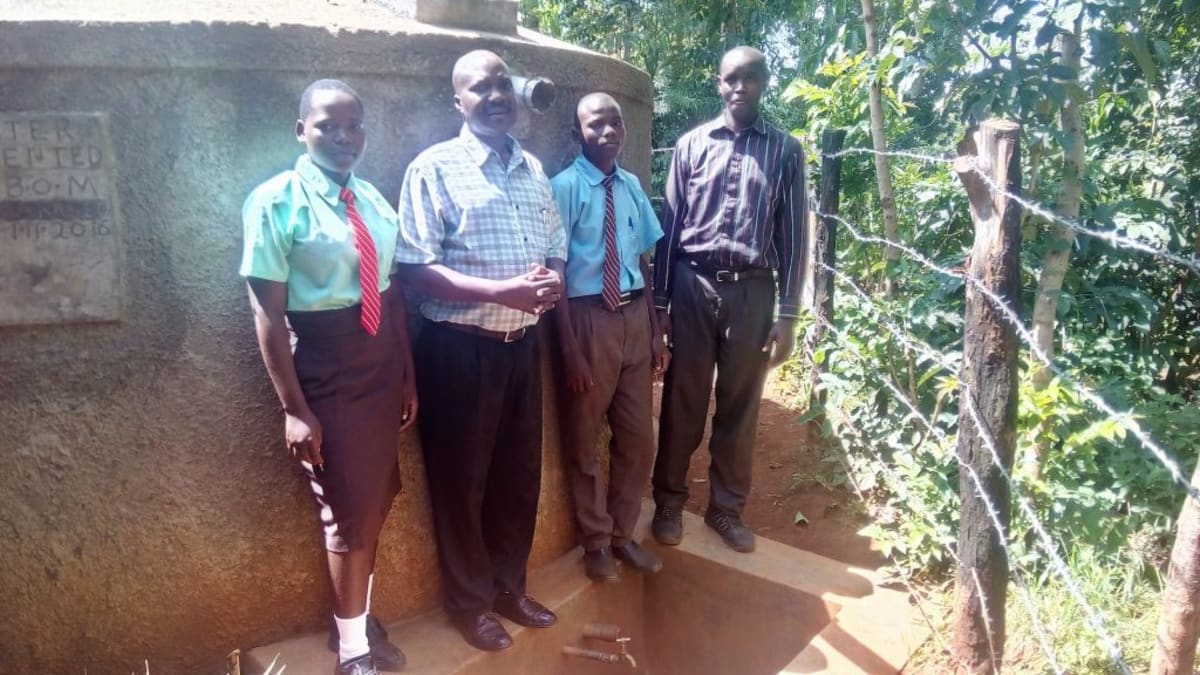This project is a part of our shared program with Western Water And Sanitation Forum (WEWASAFO). Our team is pleased to directly share the below report (edited for clarity, as needed).
Welcome to the School
St. Stephen Eshihaka Secondary School is a new school in Mushikori Village, having opened in 2013. It has a total enrollment of 140 students and employs nine teachers and six supplementary staff.
Students arrive at school around 6:30AM to clean classrooms, latrines, and pick up trash outside. Normal classes start at 8AM.
The headteacher heard about water, sanitation and hygiene projects through peers at Lusengeli Secondary School. Soon after seeing it for himself, the headteacher sent in an application to our office.
Water Situation
The primary school in the village has a well, but not this secondary school. The well is hand-dug and is approximately one kilometer away from St. Stephen. Students can also venture to a spring that is also one kilometer away from their school. The trips to and from the water sources significantly cut into valuable class time. While some classes focus on cleaning the school facilities, others are sent on trips to the water sources.
While there's good water at these sources, they are both too far away from St. Stephen. It is likely that water becomes contaminated on the long trip back to school. Once the full 20-liter jerrycans are lugged back to school, they are kept near the office until used up and ready for another trip.
After drinking water that has been fetched and stored improperly, students and staff suffer from typhoid, cholera, bilharzia, diarrhea, and stomachaches. Students miss class to stay home and recover. Teacher Wellington Okulia said "The search for water and long lines at the primary section have made many students not join the school. Parents are not willing to bring their children to the school, fearing poor performance and great risk of poor health."
Sanitation Situation
Not only does the school lack its own water source, but it doesn't have enough of its own facilities. It doesn't have a kitchen and thus borrows space from the neighboring church. When the church has an event, there are conflicts. The school doesn't have nearly enough latrines for girls, and they suffer unhygienic conditions that cause infections.
Since this secondary school is still fairly new, it hasn't been able to add facilities since its opening. There are only six latrines, all used for students and teachers alike. Different classes of students are assigned latrine cleaning duty each morning. Though regularly cleaned, the latrines are already in bad condition. The hinges on the doors have broken off and cannot provide privacy.
There are three hand-washing stations outside of the latrines, but they do not have a cleaning agent available. There is a garbage pit at the back of the school compound that helps consolidate waste and keep the environment clean.
Plans: Hygiene and Sanitation Training
Parents, teachers, and students will be trained for two days of sessions on hygiene and sanitation.
This training is meant to equip participants with the skills needed to practice good hygiene, and to promote these practices among peers and the greater community. The end goal is to eliminate water and hygiene-related diseases!
The facilitator plans to use PHAST (Participatory Hygiene and Sanitation Training), CTC (child to child), discussions, lectures, and demonstrations to teach topics including but not limited to disease transmission, hand-washing, and water treatment. After our initial assessment of conditions, our facilitator also plans to strongly emphasize proper water handling and storage. The CTC method will prepare students to lead other students into healthy habits, as well as kickstart a CTC club for the school.
Plans: Rainwater Catchment Tank
A 30,000-liter rainwater catchment tank will be constructed on school grounds. Teachers, students, and parents will gather the local materials needed for this project, including sand, ballast, bricks, and hardcore (Which they’ve already started doing!). This contribution will fuel a sense of responsibility for the school and community to take care of their new facilities. Once materials are mobilized, the WEWASAFO team will arrive to lead the construction effort. Once construction wraps up, the tank will begin collecting valuable rainwater that will be disinfected with chlorine; water that is safe for drinking, cooking, cleaning, and everything else students need!
Plans: VIP Latrines
Two triple-door latrines will be constructed, providing three new latrines for each gender. Latrine materials will be mobilized the same way as the tank, ensuring the school feels these facilities are truly theirs. And with a rainwater catchment tank nearby, there will be enough water to keep them clean.
Plans: Hand-Washing Stations
Two hand-washing stations will be delivered to the school before training, supplementing the existing stations. These come in the form of two 60-liter containers fitted with a tap. The training facilitator will demonstrate how to properly wash hands, and then students will have a chance to practice in groups. The CTC club will be responsible for filling the hand-washing containers on a daily basis and seeing that there's enough cleaning agent. They will be able to follow through with this thanks to the water tank on school grounds!
The actions described above will give students an environment that is conducive to learning. It’ll free up so much time that was used going to and from the spring. This is an opportunity they deserve!

 Rainwater Catchment
Rainwater Catchment
 Rehabilitation Project
Rehabilitation Project
























